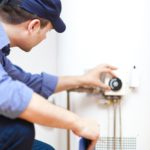Whether it’s in your refrigeration, heating and ventilation, or water system, leaks are not an issue to be taken lightly.
Although often barely noticeable and harmless if spotted and treated promptly, leaks will only grow into a bigger problem if left undetected. The consequences of a leak can be enormous and costly, ranging from reduced efficiency, higher operational costs and adverse impacts on the natural environment.
Most seriously however, human health and safety can be compromised if dangerous substances – such as some gases – are allowed to leak. As such, having strategies and tools in place to quickly and accurately detect leaks is imperative.
There are many ways of detecting leaks, and the most suitable method will differ according to industry and what substance is actually being measured. One of the most efficient techniques nowadays is tracer gas testing, which involves the use of high-quality leak detection equipment, to efficiently detect a range of leaks.
What is tracer gas testing?
As its name would suggest, tracer gas testing uses different types of gas to identify areas of leakage in your refrigeration, gas, water or other systems. The most commonly used types of gas are helium, hydrogen and halogen.
While all three gases are still widely used, helium is gaining traction in particular as the preferred option for many professionals. This is mainly due to its high sensitivity, safety and proven effectiveness, as it is a relatively safe gas – it is not flammable, nor is it harmful to human health.
Its physical makeup also allows it to seep into even the faintest of cracks, providing a reach not offered by other gases.
In addition, growing restrictions around the use of halogen under environmental protection laws is driving more attention and appeal towards helium testers.
What are the benefits?
One of the greatest advantages of this method is that it is perhaps among the most accurate out there. The use of a single, defined gas means that it is the only factor influencing the test, with no other confounding factors affecting results.
It’s also known as a nondestructive method, meaning it simply does what it needs to – test for and detect any leakage – without causing damage to the affected system or environment. As most tracer gases are inert, tasteless and odourless, they represent an incredibly safe and unobtrusive way of detecting leaks.
The best detectors or ‘sniffers’ used in these tests are highly sensitive, giving you the most accurate readings possible and instantly alerting you to areas that need attention.
What tools do I need?
In order to carry out tracer gas testing, you’ll need the right tools for the job. Fortunately, testo offers a wide range of quality, German-manufactured leak detection equipment to help you maintain safety and efficiency in your workplace.
The testo 316-3, for instance, is a highly flexible tool that can detect the most common refrigerants, such as CFC, HFC and HCFC. One of its greatest benefits is its simplicity – it’s ready to go from the moment you switch it on, with no need to fiddle around with pre-settings. A LED indicator as well as an audible alarm alerts you instantly of areas of leakage.
The testo 316-4 Set 1 is another option you may look at investing in, offering much of the same functionalities and power as the 316-3. As well as optical and audible alerts, this set also features an earplug socket, allowing you to carry out accurate testing and locating even in loud environments. Sensor settings can easily be adjusted by the user.
No matter which tool you choose, make sure you select a brand that offers the highest level of quality and service. To find out more, give Testo a call today.









 Reduce cooking oil costs while ensuring quality
Reduce cooking oil costs while ensuring quality Expert knowledge on CO2 monitoring
Expert knowledge on CO2 monitoring Refrigeration knowledge - in 3 modules
Refrigeration knowledge - in 3 modules



